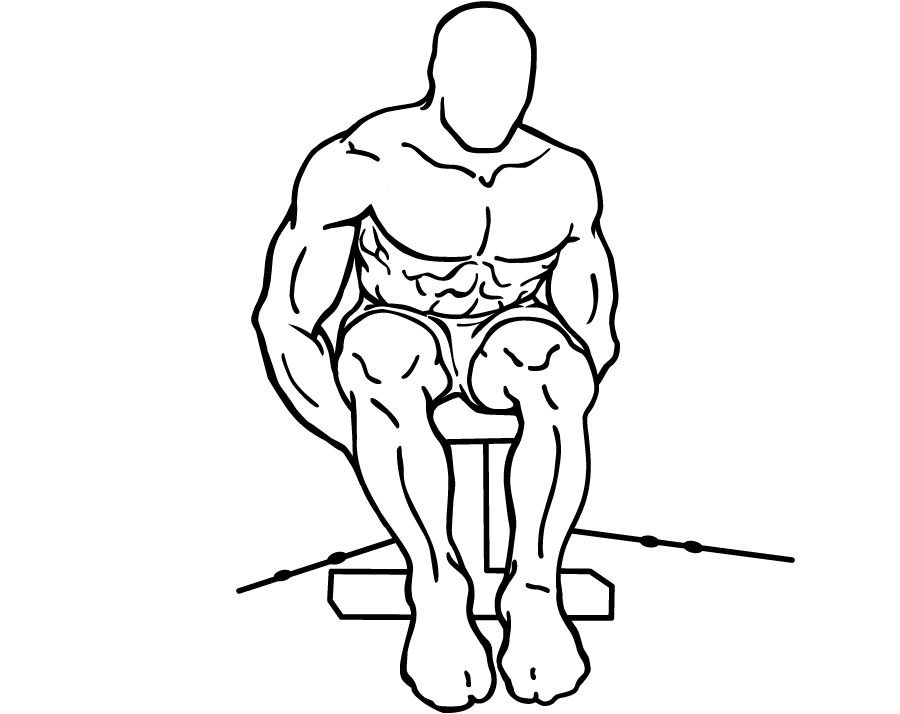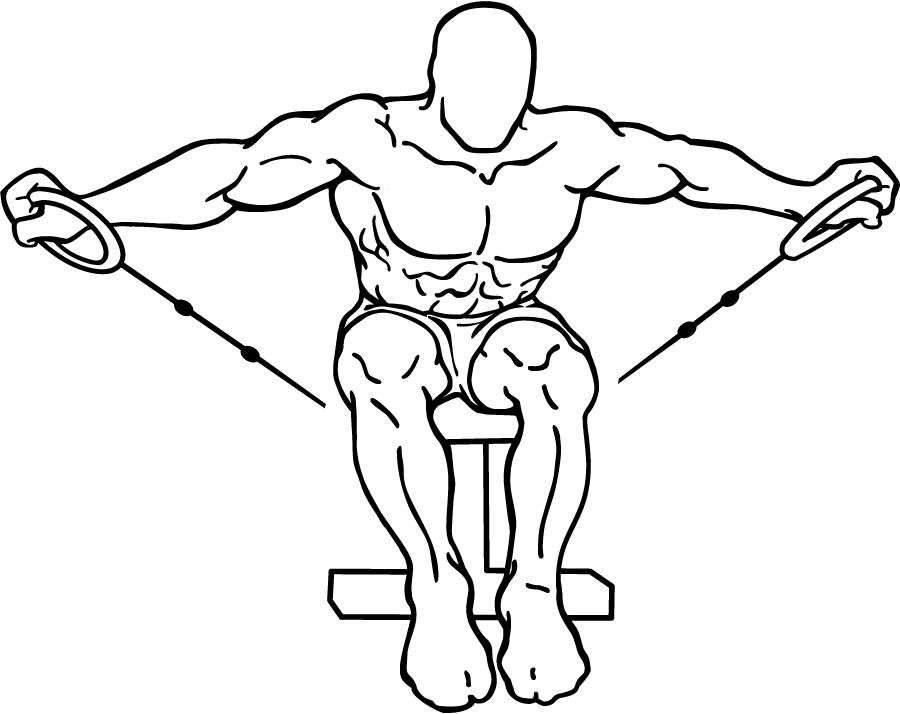Last Updated on September 26, 2014
The Seated Rear Lateral Cable Raise is an exceptional shoulder exercise, especially for those aiming to target the often-overlooked rear deltoids. This exercise not only helps in enhancing shoulder strength but also plays a vital role in achieving balanced muscle development in the upper body, which is essential for aesthetics, posture, and performance.
In this detailed guide, we’ll cover everything you need to know about the seated rear lateral cable raise, from a step-by-step breakdown of the exercise to its benefits, common mistakes to avoid, and advanced tips to ensure you’re getting the most out of every rep.
Benefits of the Seated Rear Lateral Cable Raise
- Targets Rear Deltoids: Unlike many shoulder exercises that focus on the front or side deltoids, the rear lateral cable raise hones in on the rear deltoids, improving shoulder symmetry and upper body aesthetics.
- Improves Shoulder Stability: By working the posterior deltoids and other stabilizing muscles, this exercise helps to reinforce shoulder stability, which can prevent injuries and enhance performance in other upper-body exercises.
- Enhances Posture: Strengthening the rear delts helps counteract the effects of poor posture that often come from prolonged sitting or forward-oriented activities.
- Supports Compound Movements: Strong rear deltoids contribute to improved performance in compound exercises like bench presses, rows, and pull-ups.
How to Perform the Seated Rear Lateral Cable Raise: Step-by-Step Guide
Step 1: Setting Up
- Begin by positioning a bench between two low pulley machines. Adjust the pulleys to their lowest height and attach D-handle grips to each cable.
- Sit on the edge of the bench with your feet flat on the floor, slightly wider than hip-width apart for a stable base.
Step 2: Grasp the Cable Handles
- Lean forward, keeping your back straight and your chest resting on your thighs. This position minimizes any upper body movement, isolating the rear deltoids.
- Reach across your body and grasp the right cable handle with your left hand and the left cable handle with your right hand. This cross-over position ensures that the cables provide consistent tension throughout the movement.
Step 3: Begin the Raise
- Start with your arms extended down towards the floor, with a slight bend in your elbows to reduce joint strain.
- Engage your rear deltoids as you slowly raise your arms outward and upward, bringing your upper arms to shoulder height.
- Maintain a controlled motion and avoid using momentum. Your chest should stay on your thighs to prevent any unnecessary swinging.
Step 4: Pause and Squeeze
- At the top of the movement, pause briefly and squeeze the rear deltoids. This momentary hold intensifies the contraction, helping to stimulate muscle fibers for growth and strength.
Step 5: Lower Back Down
- Lower your arms back down to the starting position in a slow, controlled manner, keeping tension on the cables to maximize muscle engagement.
- Avoid letting the weights pull your arms down too quickly, as a controlled descent ensures that the muscles remain engaged throughout the entire range of motion.
Step 6: Repeat
- Aim for 3-4 sets of 8-12 reps, focusing on form over heavy weights to ensure that you’re isolating the rear deltoids effectively.
Advanced Tips for Maximizing Your Workout
- Focus on Form: This exercise is highly technical and benefits from slow, precise movements. Ensure your back is straight and avoid lifting your chest off your thighs during the exercise.
- Use Lighter Weights: Since this movement targets smaller muscles, start with lighter weights and prioritize quality reps over quantity.
- Experiment with Grip Positioning: A slight change in grip can affect which part of the deltoids is most activated. Try adjusting the angle of your grip to see what best isolates your rear deltoids.
- Control the Eccentric (Lowering) Phase: The descent of each rep should be deliberate and slow. This phase is just as important as the lift for engaging the rear deltoids.
Variations of the Seated Rear Lateral Cable Raise
1. Standing Rear Lateral Cable Raise
- Stand instead of sitting on a bench. This position can add core stability into the exercise while still targeting the rear deltoids.
2. Single-Arm Seated Rear Lateral Cable Raise
- Work one arm at a time, allowing you to concentrate on form and engage the muscle without compensating with the other arm.
3. Seated Rear Dumbbell Raise
- If cable machines aren’t available, this exercise can be done with dumbbells, allowing a similar range of motion, though lacking the continuous tension that cables provide.
Common Mistakes to Avoid
- Lifting Too Heavy: Since the rear deltoids are relatively small, using too much weight leads to poor form and can engage other muscle groups, reducing the effectiveness of the exercise.
- Swinging or Using Momentum: Swinging your upper body lessens the tension on the rear delts. Keep your chest on your thighs and focus on controlled, slow movements.
- Elbows Flaring Too High: Raising your elbows too high can involve the upper traps and reduce the activation of the rear delts. Aim to lift your arms just to shoulder height.
- Neglecting the Negative (Eccentric) Phase: A common mistake is to let the weights drop down quickly. Controlling the lowering movement ensures full muscle engagement and promotes better gains.
- Not Adjusting the Cable Height Properly: If the cables are too high, they might strain the shoulder. Ensure they are set to the lowest height to allow a natural movement path.
How to Integrate This Exercise into Your Routine
- On Shoulder Day: Incorporate the seated rear lateral cable raise toward the middle or end of your shoulder workout to target the rear delts after heavier pressing movements.
- Part of a Back Routine: Since the rear deltoids assist in pulling movements, you can also include this exercise on back day to ensure balanced shoulder development.
- As a Pre-Exhaust Exercise: Use this exercise at the beginning of a shoulder workout to pre-exhaust the rear delts before moving on to heavier lifts.
Muscle Anatomy and Mechanics: Why This Exercise Works
The deltoid muscle is divided into three distinct heads: anterior (front), lateral (side), and posterior (rear). While most shoulder exercises prioritize the anterior and lateral heads, the posterior deltoid often goes undertrained. The seated rear lateral cable raise isolates this head, helping to create a balanced shoulder. This isolation also reinforces upper body stability and strength, as the rear delts play a significant role in supporting the shoulder joint.
Frequently Asked Questions
1. Can I use dumbbells if cables aren’t available?
- Yes, dumbbells can be an effective substitute for this exercise. However, cables provide constant tension that dumbbells lack, which is beneficial for isolating the rear delts.
2. What’s the ideal rep range for building rear delts?
- Rear delts often respond well to higher reps, so aiming for 12-15 reps per set can be effective. However, keeping it between 8-12 reps works well for hypertrophy as long as form is maintained.
3. How often should I train my rear delts?
- Rear delts recover relatively quickly, so training them 2-3 times a week can yield good results without risking overtraining.
Importance of Rear Delt Training
In addition to the aesthetic benefits, rear delt training is crucial for maintaining healthy shoulders. Balanced shoulder muscles prevent issues like impingements, which can arise from an overdeveloped anterior deltoid and underdeveloped posterior deltoid. Strong rear delts also improve shoulder stability, especially in activities that involve pushing or pressing.
By adding seated rear lateral cable raises into your routine, you’re not only enhancing the look of your shoulders but also promoting long-term shoulder health.
Safety Precautions
- Check the Cable Height: Always ensure the cables are set at the lowest position for a smooth range of motion.
- Choose an Appropriate Weight: Lighter weights will help you focus on form and avoid using your traps to compensate.
- Avoid Arching Your Back: Maintain a neutral spine by keeping your back straight and your chest on your thighs throughout the exercise.
- Don’t Rush: Slow, controlled movements are essential to fully engage the rear deltoids and reduce the risk of injury.
Wrapping Up: Building Balanced and Strong Shoulders
The Seated Rear Lateral Cable Raise is an excellent addition to any shoulder or upper body routine. This targeted exercise emphasizes the rear deltoids, helping to create balanced shoulder muscles, improve posture, and enhance upper body stability.
Start light, perfect your form, and progressively increase the weight to continue challenging your muscles. With consistency, this movement will contribute to a more defined, resilient shoulder structure that supports your performance in both the gym and daily life.








